NDVI stands for "Normalized Difference Vegetation Index". NRG stands for "Near-infrared / Red / Green". NDVI and NRG are both ways to visualize the amounts of infrared and other wavelengths of light reflected from vegetation. Because both these methods compare ratios of blue and red light absorbed versus green and IR light reflected, they can be used to evaluate the health of vegetation. It's a snapshot of how much photosynthesis is happening. This is helpful in assessing vegetative health or stress. (Read more here: https://www.agronomy.org/publications/jeq/articles/36/3/832) ## Do-It-Yourself These techniques for vegetation analysis were developed for satellite imagery, but at Public Lab, we've been working a lot on capturing infrared imagery using our DIY [near-infrared camera](/wiki/near-infrared-camera) setup, and combining it with visible bands to produce NDVI images such as the one above. ## What these images mean What exactly are these images we're trying to make? What do they tell us about vegetation, and why? These diagrams should help to understand what it is we're doing and why these are good ways to analyze plant life. ## The NDVI equation [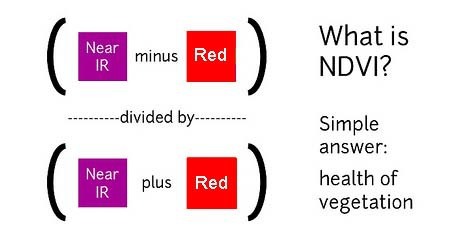](/i/44723) **NDVI = (Near Infrared - Red)/(Near Infrared + Red)** NDVI is a ratio which tries to emphasize photosynthesis while filtering out sun glare. The above equation is run for every pixel, using source data from an infrared photo and a visible light photo, like this pair: [](https://publiclab.org/system/images/photos/000/021/771/original/5390895115_c9d4d38fec_o.jpg) The result can be false-colored to make the high-photosynthesis areas more clear, and used to examine where plants are and how healthy they are. [](https://publiclab.org/system/images/photos/000/021/770/original/PetVISNDVIcomp.png) _Figure above: Normal color photo (right) and normalized difference vegetation index (NDVI) image (left). NDVI image was derived from two color channels in a single photo taken with a camera modified with a special infrared filter. Note that tree trunks, brown grass, and rocks have very low NDVI values because they are not photosynthetic. Healthy plants typically have NDVI values between 0.1 and 0.9. -- @cfastie_ ### Activities Here are a range of activities you can do to produce and interpret your own NDVI imagery, whether downloaded from a satellite imagery provider or [collected yourself using a DIY technique](/wiki/multispectral-imaging) [activities:ndvi] ****   Most DIY converted cameras today (those from Public Lab) use RGN instead of NRG, so the blue channel represents infrared instead of the red channel. That looks like this: [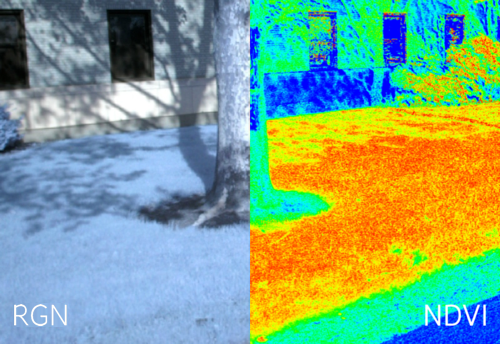](/i/45468?s=o) **** ## NRG imagery Some people are also interested in producing NRG imagery (like the below image), where `Near-Infrared, Red, and Green` are used to compose a picture instead of the usual `Red, Green, and Blue`. [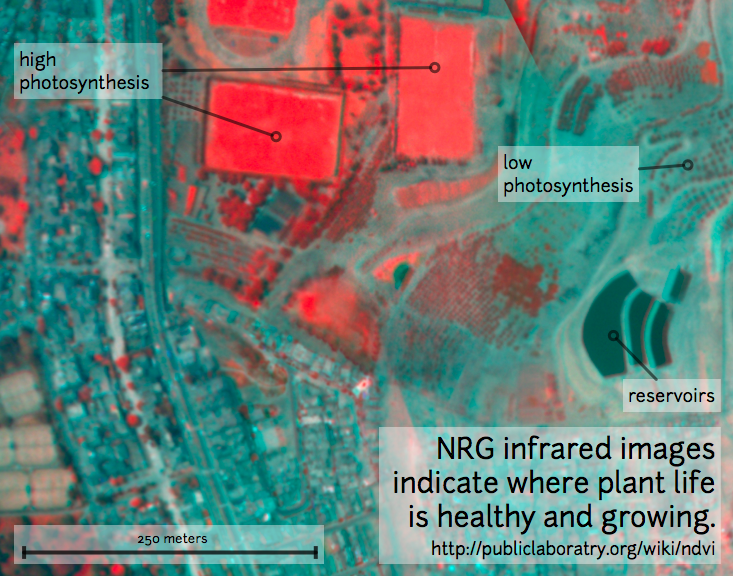](/i/25064) This diagram explains the swapping, which allows us to 'see' infrared as if it were a normal color: [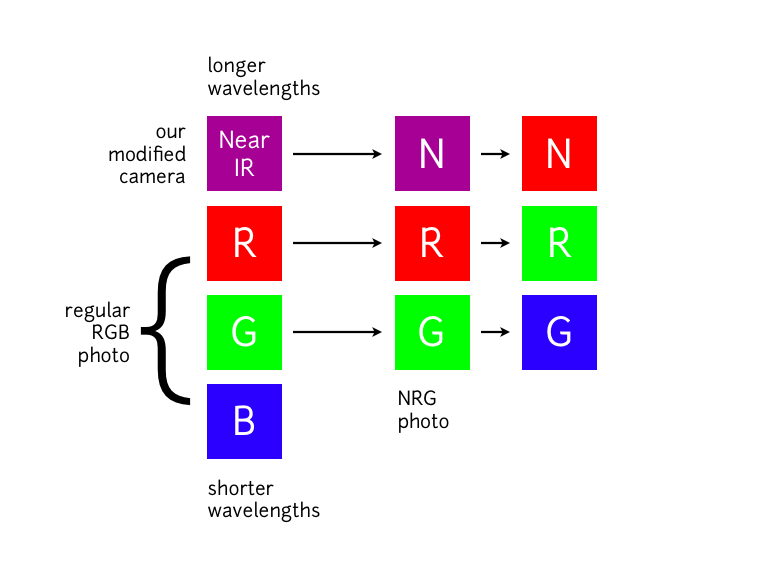](/i/25063) **In NRG images, the deeper and clearer the red color, the denser and healthier the vegetation (more or less).** ### Questions [questions:ndvi] ### Other examples of DIY NDVI imaging From around the internet: Begin watching at 2 minutes to see the resulting imagery: *This topic is part of the [Grassroots Mapping Curriculum](/wiki/mapping-curriculum) series.* **** [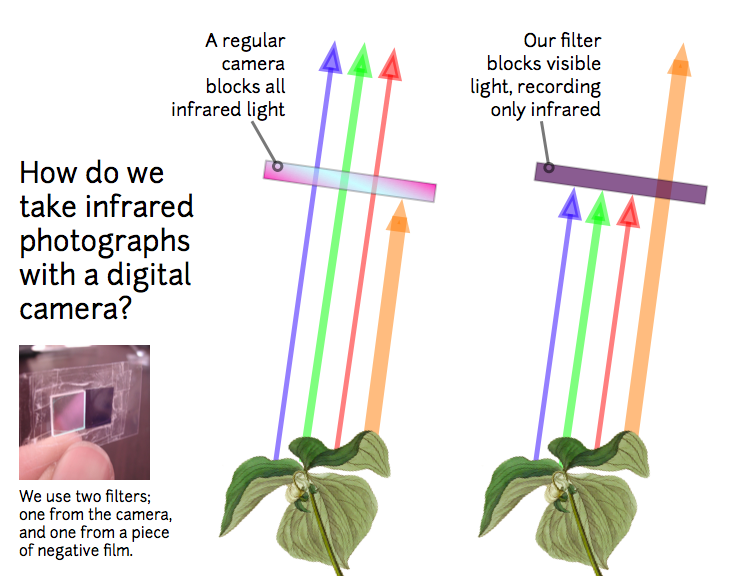](/i/25066) [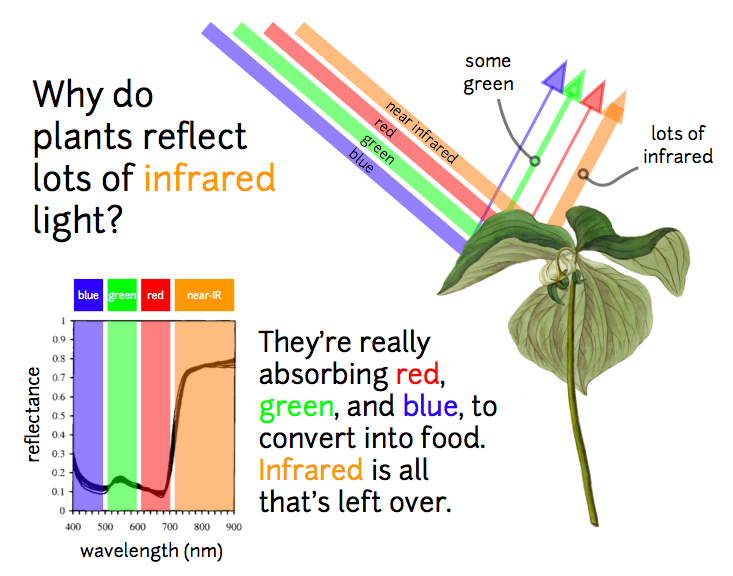](/i/25065) ...
| Author | Comment | Last activity | Moderation | ||
|---|---|---|---|---|---|
| theowallis | "Thanks for your comment, this is what I was afraid of; there is no relatively simple way to isolate specific wavelengths and furthermore if this wa..." | Read more » | over 10 years ago | |||
| patcoyle | "Thanks Chris. As always I appreciate your tips. I'll have to take a look at these points. " | Read more » | over 10 years ago | |||
| cfastie | "Great application. I assume your camera but not you got to go in the plane? How was the camera triggered? Was it mounted on the plane? What was th..." | Read more » | over 10 years ago | |||
| cfastie | "Hi Pat, The Wratten 87 passes only NIR; it's great for the NIR camera in a dual camera rig. The Wratten 25 is the best filter I have used for a sin..." | Read more » | over 10 years ago | |||
| patcoyle | "Chris, Nice rig. Great value. I like the results. Has there been discussion of the Wratten 87 polyester filter vs Wratten 25? " | Read more » | over 10 years ago | |||
| cfastie | "That's a tough one. With the IR blocking filter removed, all three color channels (all pixels, regardless of which color array filter they are unde..." | Read more » | over 10 years ago | |||
| theowallis | "My second lens arrived today and I reluctantly performed the same procedure (with a slight difference) on it. I went out and bought a glass cutter ..." | Read more » | over 10 years ago | |||
| theowallis | "Yeah I'm stumped too. As you said, I can only think it's a loose element inside the remaining lens assembly. I've ordered another lens to repeat th..." | Read more » | over 10 years ago | |||
| mathew | "The sensor is screwed in straight to the lens assembly, so the issue must be some other focus hardware, or a loose piece inside the lense itself. I..." | Read more » | over 10 years ago | |||
| theowallis | "Nothing rattles when I shake the lens but reassembling the case (or any movement/vibration) alters the focus. I haven't installed a new filter yet...." | Read more » | over 10 years ago | |||
| cfastie | "theowallis, Did you add a new filter to replace the IR block filter? Where did you put it? Do you think it is the act of tightening the set screw ..." | Read more » | over 10 years ago | |||
| warren | "Hmm, i once saw this with a different camera, where the filter was helping to pressure the lens into place, and removing it let the lens rock back ..." | Read more » | over 10 years ago | |||
| theowallis | "Just a friendly warning for those of you looking to attempt this conversion, I did this last week, it wasn't too hard to smash the ir blocker out b..." | Read more » | over 10 years ago | |||
| cfastie | "Hi Scott, A Gigapan account is free, although you can pay for commercial features. The minimum limit on all gigapan uploads is 50 megapixels (not m..." | Read more » | over 10 years ago | |||
| eustatic | "chris, how does one create the embedded display you've made in Gigapan. i love the way you can display your photos. I've tried signing up for gig..." | Read more » | over 10 years ago | |||
| warren | "Mathew just had trouble uploading lots of photos too, so perhaps it chokes on large uploads. If you could just upload the one raw image with a red ..." | Read more » | over 10 years ago | |||
| natalie | "I guess. What a pain in the butt. I tried for about an hour to post them at the original size and the wiki just said updating, perpetually and neve..." | Read more » | over 10 years ago | |||
| mathew | "There's an application for linux-- GUVCView that should let you capture full resolution 1200x1600) in the settings. " | Read more » | over 10 years ago | |||
| warren | "Hi, Natalie - thanks for updating, but your photos are really tiny -- is there any way you can post them at full resolution? They look promising, b..." | Read more » | over 10 years ago | |||
| natalie | "Okay check out my updates. @warren, @mathew, @cfastie " | Read more » | over 10 years ago | |||
| warren | "Here are the notes and test photos from when we originally chose the current webcam http://publiclab.org/notes/warren/09-08-2013/infragram-webcam-..." | Read more » | over 10 years ago | |||
| mathew | "white balance is tough-- I only remember control of exposure in UVC. look at these programs: http://publiclab.org/wiki/spectral-workbench-usage#We..." | Read more » | over 10 years ago | |||
| warren | "I also updated http://publiclab.org/wiki/infragram#Filters with red/blue filter information. I believe all webcams are CMOS sensors so I'm not actu..." | Read more » | over 10 years ago | |||
| warren | "The blurry photo looks interesting though... " | Read more » | over 10 years ago |